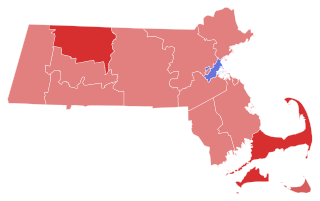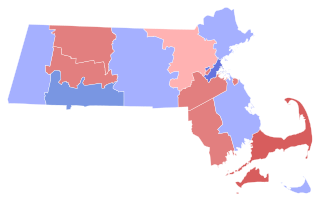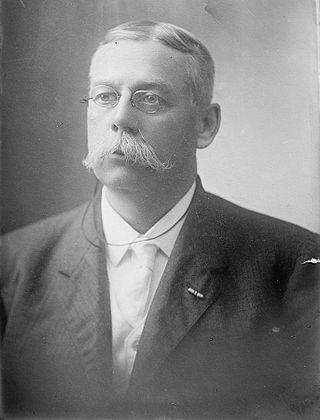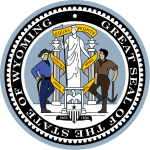
The 1918 United States Senate elections were held throughout 1918, the midpoint of Woodrow Wilson's second term as president. This was the first election since the ratification of the 17th Amendment that all 32 Class 2 senators were subject to direct or popular election, making them the final class under the old system of being selected by state legislatures. Special elections were also held to fill vacancies.

Joseph Maull Carey was an American lawyer, rancher, judge, and politician, who was active in Wyoming local, state, and federal politics.

The 1912–13 United States Senate elections were held on various dates in various states. They were the last U.S. Senate elections before the ratification of the Seventeenth Amendment in 1913, establishing direct elections for all Senate seats. Senators had been primarily chosen by state legislatures. Senators were elected over a wide range of time throughout 1912 and 1913, and a seat may have been filled months late or remained vacant due to legislative deadlock. Some states elected their senators directly even before passage of Seventeenth Amendment. Oregon pioneered direct election and experimented with different measures over several years until it succeeded in 1907. Soon after, Nebraska followed suit and laid the foundation for other states to adopt measures reflecting the people's will. By 1912, as many as 29 states elected senators either as nominees of their party's primary or in conjunction with a general election.

The 2008 United States Senate special election in Wyoming took place on November 4, 2008, at the same time as the regular election to the United States Senate in Wyoming. The special election occurred to complete the term of Republican incumbent Craig L. Thomas, who won reelection in 2006, but died in June 2007. Despite being a Democrat, Governor Dave Freudenthal was obliged by state law to appoint a Republican, and selected state senator John Barrasso, who was unopposed in the Republican primary and won the general election to fill the remainder of the term ending January 3, 2013. This is the last time that both of Wyoming‘s U.S. Senate seats were concurrently up for election.

The 1996 United States Senate election in Wyoming was held November 5, 1996. Incumbent Republican U.S. Senator Alan K. Simpson decided to retire. Republican nominee Mike Enzi won the open seat.

The 1926 United States Senate special election in Massachusetts was held on November 2, 1926.

The United States Senate election of 1924 in Massachusetts was held on November 4, 1924. Incumbent Democratic Senator David I. Walsh, first elected in 1918, ran for a second term in office but was defeated by the Republican nominee incumbent Speaker of the U.S. House Frederick H. Gillett. Despite winning 13 out of 14 counties in the state, Gillett was only able to win a narrow margin of 1.7%, which was largely due to Walsh's strong performance in Suffolk County, home to the state capitol of Boston, likely being carried over by fellow Republican Calvin Coolidge's strong performance in the 1924 United States presidential election.

The United States Senate election of 1918 in Massachusetts was held on November 5. Incumbent Republican Senator John W. Weeks ran for a second term in office but was defeated by Democratic former Governor David I. Walsh.

The United States Senate special election of 1938 in New Jersey was held on November 8, 1938.

The 1924 United States Senate election in Wyoming took place on November 4, 1924. Incumbent Republican Senator Francis E. Warren ran for re-election to his sixth consecutive term in the Senate. He was challenged by Judge Robert Rose of the Eighth Judicial District of Wyoming, the Democratic nominee. The election took place on the same ballot as the presidential election, with Republican Calvin Coolidge winning Wyoming by a wide margin, and the special gubernatorial election, with Democratic Nellie Tayloe Ross similarly winning by a wide margin. Both Warren and Rose outperformed their party's presidential nominees, and Warren ultimately won re-election by a wide margin, albeit reduced from 1918. This would be Warren's last term in the Senate; he died on November 24, 1929, with a little more than a year remaining in his term. Republican Patrick Joseph Sullivan was appointed to replace him.

A general election was held in the U.S. state of Wyoming on November 6, 2018. All of Wyoming's executive offices were up for election, as well as a United States Senate seat and Wyoming's at-large seat in the United States House of Representatives. Primary elections were held on August 21, 2018.

The 1994 Wyoming gubernatorial election took place on November 8, 1994. Incumbent Democratic Governor Mike Sullivan was unable to seek a third term because of newly imposed term limits, and instead ran for the U.S. Senate. State Senate President Jim Geringer won the Republican primary and faced Secretary of State Kathy Karpan, the Democratic nominee, in the general election. Aided by the nationwide Republican wave, Geringer defeated Karpan in a landslide, marking the first time since Governor Stanley Hathaway's re-election in 1970 that a Republican won a gubernatorial election in Wyoming.

The 1890 Wyoming gubernatorial election was held on September 11, 1890, as the first gubernatorial election for the newly admitted state of Wyoming. Incumbent Territorial Governor Francis E. Warren ran for re-election as the Republican nominee against former Territorial Governor George W. Baxter, the Democratic nominee. Warren defeated Baxter by a decisive margin and became the first popularly elected Governor of Wyoming.

The 1892 Wyoming gubernatorial special election was held on November 6, 1892. Republican Governor Francis E. Warren, who was elected in 1890, resigned several weeks into his term after being elected to the U.S. Senate by the state legislature, elevating Secretary of State Amos W. Barber to the governorship and triggering a special election for the balance of Warren's term.

A general election was held in the U.S. state of Wyoming on Tuesday, November 7, 1962. All of the state's executive officers—the Governor, Secretary of State, Auditor, Treasurer, and Superintendent of Public Instruction—were up for election. Republicans ran the table on the state's executive offices, defeating incumbent Governor Jack R. Gage and incumbent Superintendent Velma Linford and picking up the Secretary of State's office. Republican State Auditor Minnie A. Mitchell was re-elected and Republicans also held the Treasurer's office.

A general election was held in the U.S. state of Wyoming on September 11, 1890, to elect the state's executive officers—the governor, secretary of state, auditor, treasurer, and superintendent of public instruction—which were created in the state constitution adopted in 1889. This was the first election in which these offices were for election. The Republican Party performed well, carrying all of them by double-digit margins.

A general election was held in the U.S. state of Wyoming on Tuesday, November 7, 1922. All of the state's executive officers—the Governor, Secretary of State, Auditor, Treasurer, and Superintendent of Public Instruction—were up for election. Democrats improved considerably from their performances in 1918, with William B. Ross winning the gubernatorial election and almost all of their statewide candidates outpacing their 1918 nominees. However, Republicans held all of the other statewide offices.

A general election was held in the U.S. state of Wyoming on Tuesday, November 6, 1894. All of the state's executive officers—the Governor, Secretary of State, Auditor, Treasurer, and Superintendent of Public Instruction—were up for election. The Republican Party, helped by the strong performance of the Populist Party, which operated as a spoiler to the Democratic Party, won back the governorship and improved its margin of victory in all other statewide offices.

A general election was held in the U.S. state of Wyoming on Tuesday, November 3, 1914. All of the state's executive officers—the Governor, Secretary of State, Auditor, Treasurer, and Superintendent of Public Instruction—were up for election. Governor Joseph M. Carey declined to seek re-election to a second term, and Democratic State Senator John B. Kendrick was elected as his successor. Republicans, however, won all of the other statewide executive offices, including picking up the Superintendent's office.

A general election was held in the U.S. state of Wyoming on Tuesday, November 5, 1918. All of the state's executive officers—the Governor, Secretary of State, Auditor, Treasurer, and Superintendent of Public Instruction—were up for election. Republicans won all statewide offices by wide margins, and with Robert D. Carey's defeat of Frank L. Houx, picked up the governorship following two consecutive losses to Democrats.

















